Famous Op Art Artists – Explore Artists Who Trick the Eye
Since the 1960s, the world of Optical art has captivated many artists and led to the production of many unique and striking artworks. The movement focused on the art of creating optical illusions and continues to thrive today with the many advancements in technology. From icons such as Bridget Riley to the impactful works of Jesús Rafael Soto and Richard Anuszkiewicz, we will introduce you to the top 13 most famous Op art artists of the last two centuries. Read on for more about these inspirational and unique icons of Op art!
Contents
- 1 Optical Art: The Magic of Visual Perception
- 2 Exploring the 13 Greatest Op Art Artists of All Time
- 2.1 Josef Albers (1888 – 1976)
- 2.2 Victor Vasarely (1906 – 1997)
- 2.3 Alejandro Otero (1921 – 1990)
- 2.4 Jesús Rafael Soto (1923 – 2005)
- 2.5 Carlos Cruz-Diez (1923 – 2019)
- 2.6 François Morellet (1926 – 2016)
- 2.7 Omar Rayo (1928 – 2010)
- 2.8 Yaacov Agam (1928 – Present)
- 2.9 Julio Le Parc (1928 – Present)
- 2.10 Richard Anuszkiewicz (1930 – 2020)
- 2.11 Bridget Riley (1931 – Present)
- 2.12 Jean-Pierre Vasarely (1934 – 2002)
- 2.13 Frank Stella (1936 – Present)
- 3 Frequently Asked Questions
Optical Art: The Magic of Visual Perception
The art movement emerged in the 20th century during the 1960s and was a movement that focused on the creation of optical illusions in visual art. At the heart of Op art was the ability to achieve visual effects that challenged viewers’ perceptions and provided a unique experience to those who appreciated the value of geometry in art. Op art was therefore one of the most impactful movements of the 20th century that challenged traditional beliefs on how visual art could be perceived.

While the origins of art could be traced back to earlier art movements such as the Bauhaus and constructivist movements, it was not until the 1960s that the movement grew traction. Optical art in the 1960s emphasized the use of simple forms and colors, as well as geometric abstraction. The name of the movement was first coined in 1964 by Lawrence Alloway, who was a prominent art critic that described the work of artists who incorporated optical illusions in their work. The movement saw a rise in the number of famous Op art artists who began to explore the relationships between form, color, and perception, and as such, the movement’s popularity grew. The father of Op art, Victor Vasarely, played a crucial role in popularizing the styles of Op art through his vibrant and geometric artworks. Among the most famous Op art artists of the 20th century was Bridget Riley, whose striking black-and-white paintings vibrate before their audience.
Since the 1960s, art has had a significant impact on the way people experience and perceive art.
Through the use of optical illusions, artists have been able to challenge traditional notions around representation, perspective, and depth, which impacted the role of the viewer as an active participant in the artistic process. As one experiences and interacts with optical artworks, one is forced to interact with the instability and visual narrative they are presented with. Optical art has always had an element of ambiguity since it challenges the viewer’s perception of form and immerses them into a range of visual effects that challenge one’s perception of movement and static space. Through an exploration of different visual effects, as a result of Op art’s development, optical illusions can also be found in fashion, architecture, and graphic design. Op art was the beginning of many artists’ exploration of abstraction, which transcended physical limitations and evoked intellectual responses purely through visual illusions. Such developments in visual perception shifted the art scene and enabled the emergence of other movements such as Conceptual art and Minimalism, which further tested the traditional artistic conventions of the time.
Exploring the 13 Greatest Op Art Artists of All Time
Op art was one of the most groundbreaking and revolutionary movements of the 20th century that expanded the way people experience art; its focus was on geometric patterns and illusions to highlight the relationships between an artwork and its viewers. Below, we will explore the 13 most famous Op art artists of all time who have expanded the possibilities for artistic expression and have left an enduring impact on Contemporary art.
Josef Albers (1888 – 1976)
| Name | Josef Albers |
| Date of Birth | 19 March 1888 |
| Date of Death | 25 March 1976 |
| Nationality | German
|
| Associated Movements, Themes, and Styles | Op art, Bauhaus, Geometric Abstraction, Abstract art, and Modern art |
| Mediums | Painting, drawing, and printmaking |
| Famous Artworks | ● Graphic Tectonic (1941) ● Homage to the Square: Solstice (1959) ● Homage to the Square: Sentinel (1967) ● Formulation: Articulation (1972) |
Josef Albers was among the most important Op artists of the 20th century whose career left a lasting impact on Modern art. Albers was a prominent German Op art painter and printmaker, who was most famous for his series of square artworks exploring color theory and visual perception. His series, Homage to the Squares was his most successful series in Op art that demonstrated his passion for exploring the influence of color on adjacent hues and the interplay of color and contrast as the essence of painting itself.
Albers was born in 1888 in Germany, where he studied the styles of the Bauhaus under the colorist Johannes Itten in Weimar.
Albers grew a passion for teaching and became a professor at the Dessau location, where he gained the acquaintance of artists such as Paul Klee, Wassily Kandinsky, and László Moholy-Nagy. Albers was exposed to the critical period of the 1930s, which saw the rule of the Nazi regime, and as such, he had to emigrate to the United States, where he founded a painting program that went on to influence artists such as Robert Rauschenberg and Cy Twombly. Albers’ influence on 20th-century Op art was felt in art education and his role as an artistic genius in color theory. Today, his works can be found at many iconic institutions, including the National Gallery of Art in Washington D. C. and the Tate Gallery in London.
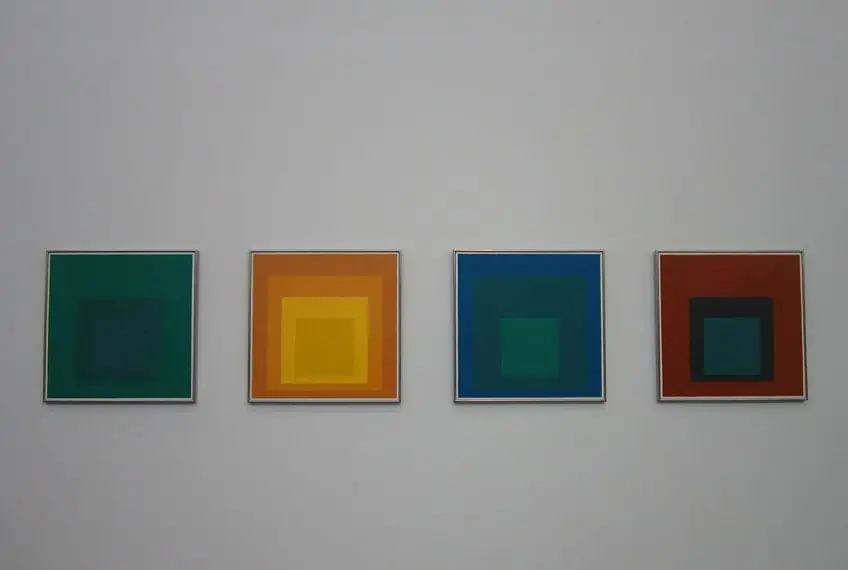
Victor Vasarely (1906 – 1997)
| Name | Victor Vasarely |
| Date of Birth | 9 April 1906 |
| Date of Death | 15 March 1997 |
| Nationality | Hungarian-French
|
| Associated Movements, Themes, and Styles | Op art, Modern art, hard-edge painting, and Cubism |
| Mediums | Painting and sculpture |
| Famous Artworks | ● The Chess Board (1935) ● Zebra (1937) ● Vega 200 (1968) ● Vega-Nor (1969) ● Vonal Stri (1975) |
Another prolific figure of the Op art movement, who was dubbed the grandfather of Op art was Hungarian-French artist Victor Vasarely. Vasarely’s unique approach to Op art made his work one of the best and most mesmerizing in the history of Op art. Through visual illusions and dynamic use of shapes, color, and patterns, Vasarely’s paintings transcend the canvas.
His artistic legacy was built on his signature style which revolves around geometric abstraction and the manipulation of form to create a sense of depth and movement in his paintings.
Vasarely’s masterful use of art and science engages the human perception of sensation by presenting contrasting colors among intricate geometric shapes to instill a sense of vibrancy and movement in each piece. Throughout his career, Vasarely won numerous accolades for his contributions to the Op art movement, including prestigious awards such as the Guggenheim prize in 1964 and the French Legion of Honor in 1971. Among his most notable op art paintings include works such as The Chess Board (1935) and Vega 200 (1968).
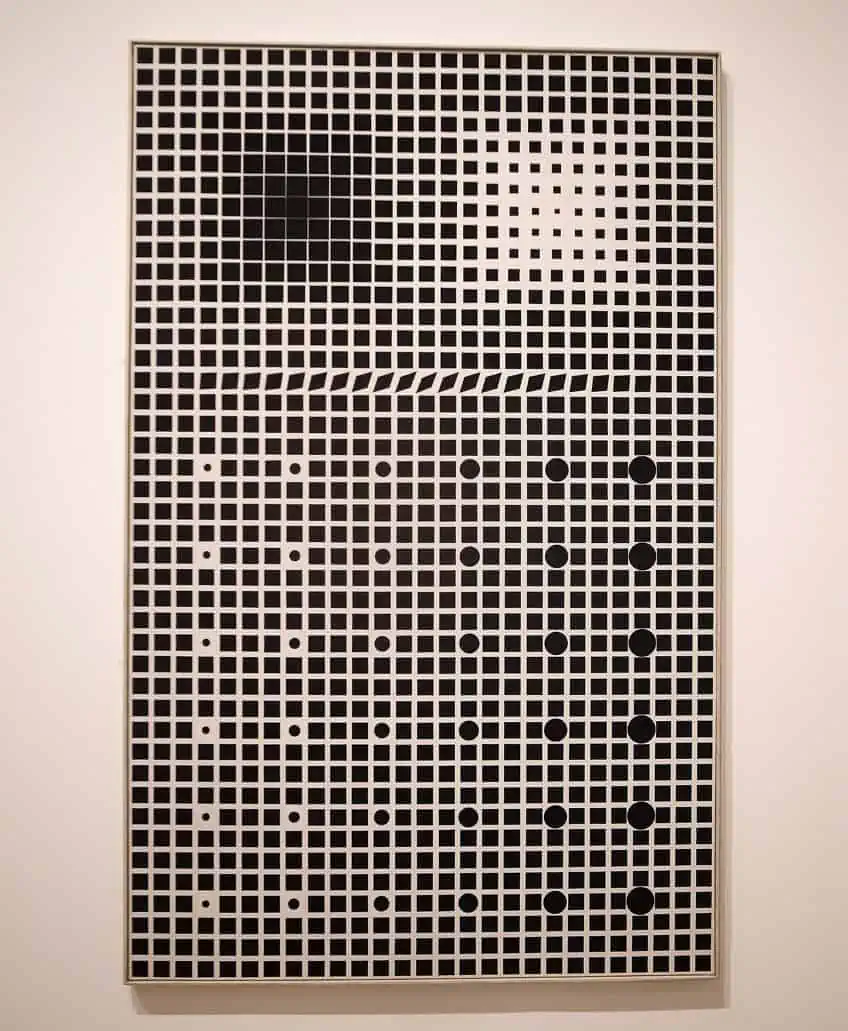
Alejandro Otero (1921 – 1990)
| Name | Alejandro Otero |
| Date of Birth | 7 March 1921 |
| Date of Death | 13 August 1990 |
| Nationality | Venezuelan
|
| Associated Movements, Themes, and Styles | Op art, Modern art, and Geometric Abstraction |
| Mediums | Sculpture, writing, and painting |
| Famous Artworks | ● Estudio 2 (Study 2) (1952) ● Tablón de Pampatar (Pampatar Board) (1954) ● Coloritmo #66 (1966) ● Delta Solar (1977) |
Alejandro Otero is one of the most significant artists from the op art movement whose legacy on the world of Contemporary art remains at the fore of understanding how optical illusions influence visual art. The famous Venezuelan artist explored the world of geometric abstraction and cemented himself as a pioneer of Op art. Otero’s innovative use of form, color, and composition is expertly portrayed in many of his notable paintings and sculptures.
Otero’s style is characterized by his rhythmic use of geometric patterns and structures that challenge conventional perceptions of space.
His sculptures and paintings are also defined by his use of line and shape to generate a sense of movement and depth that engages viewers on multiple levels. Beyond his contribution to the movement of Op art, Alejandro Otero also played a crucial role in promoting the art and culture of Venezuela across Latin America. Otero was a founding member of the Los Disidentes group, which emerged in the 1950s and advocated for abstraction and modern art in Venezuela. Otero’s work has been celebrated as masterpieces of timeless ingenuity which continues to inspire the potential of geometric abstraction in the 21st century. Among his most famous Op art works include Coloritmo #66 (1966) and Delta Solar (1977).
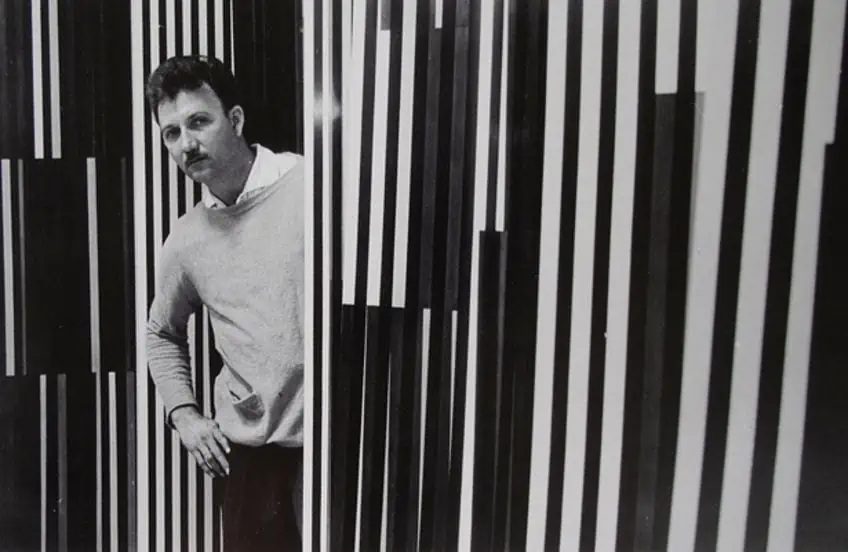
Jesús Rafael Soto (1923 – 2005)
| Name | Jesús Rafael Soto |
| Date of Birth | 5 June 1923 |
| Date of Death | 14 January 2005 |
| Nationality | Venezuelan
|
| Associated Movements, Themes, and Styles | Op art, Modern art, and Kinetic art |
| Mediums | Painting and sculpture |
| Famous Artworks | ● Vibrations Métalliques (1969) ● Cube with Ambiguous Space (1981) ● Esfera Theospacio (1989) ● Vibration Superieure (1998) ● Mirror (2005) |
Jesús Rafael Soto was perhaps the most famous Op artist of the 20th century who led the fusion of optical illusions in art with kinetic art in sculpture. Soto’s artistic journey commenced in the 1940s and by the 1960s, he was already a leading Op artist. What made Soto’s work so unforgettable was his application of kinetic art, which resulted in three-dimensional sculptures with incredible optical illusions, made even more brilliant with his integration of subtle color.
Soto’s talent in the art of illusion was noted through his use of movement across sculpture, installation, and painting, which showcased his skillful eye for curating shapes, lines, and patterns in such a way that enhances one’s visual experience.
Jesús Rafael Soto also propelled the concept of vibrations in his seemingly stationary sculptures, which produced ambiguous effects and introduced the notion of the active observer. Soto’s influence over the development of Op art in the 21st century is thus undeniable and has since opened the doors for other Op artists to explore the boundaries between kinetic and Op art.
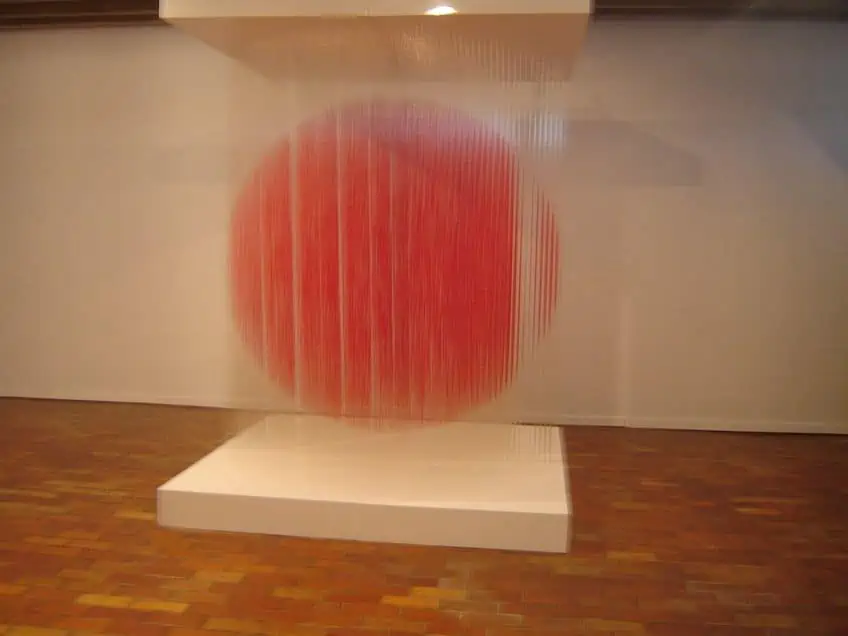
Carlos Cruz-Diez (1923 – 2019)
| Name | Carlos Cruz-Diez |
| Date of Birth | 17 August 1923 |
| Date of Death | 27 July 2019
|
| Nationality | Venezuelan |
| Associated Movements, Themes, and Styles | Op art and Modern art |
| Mediums | Serigraphy, printmaking, chromography, and sculpture |
| Famous Artworks | ● Stèle horizontale 9 (2008) ● Cromointerferencia Espacial 23 (2015) ● Induction du Jaune Tepuy 2 (2018) ● Cromovela 19 (2018) |
Carlos Cruz-Diez was among the most significant artists of the Op art movement whose works reflected the exploration of color as an autonomous element. Cruz-Diez’s unique style shaped the field of Op art by introducing the art of chromosaturation, which presented a more immersive experience for viewers.
This new style involved the construction of special rooms illuminated in different colors to induce an enhanced visual experience of the work.
His contributions were most notably seen in his study of the behavior of color in light and its effects on the perception of the artwork. Cruz-Diez’s illusions captivated many by emphasizing the relationships between light and color manipulation, which resonated with many Modern artists and theorists.

François Morellet (1926 – 2016)
| Name | François Morellet |
| Date of Birth | 30 April 1926 |
| Date of Death | 11 May 2016 |
| Nationality | French
|
| Associated Movements, Themes, and Styles | Op art, Conceptual art, Modern art, and light art |
| Mediums | Painting and sculpture |
| Famous Artworks | ● 2 doubles trames (1959) ● Trames (1965) ● 20% de carrés dégradés pivotés au centre 5 fois (1970) |
François Morellet was a notable French Op artist of the Modern and Contemporary periods, who was recognized for his contribution to Abstract Op art and Conceptual art. Morellet first began his career in still-life painting and later grew to adopt a new pictorial language through geometric abstraction and simple forms.
Credited as one of the founders of the Groupe de Recherche d’Art Visuel, Morellet also experimented with neon tube lighting and various materials, which amplified the experience of Op art and installation.
According to Morellet, “a work of art only referred to itself”, which was a philosophy he adopted from the Nihilism of Modernist sculptor Marcel Duchamp. Morellet’s approach to Op art was largely informed by his use of geometry in art as a means to create emotionally neutral art. Among his list of artists he admired was the work of Op artist Frank Stella, who influenced his approach to post-painterly abstraction.
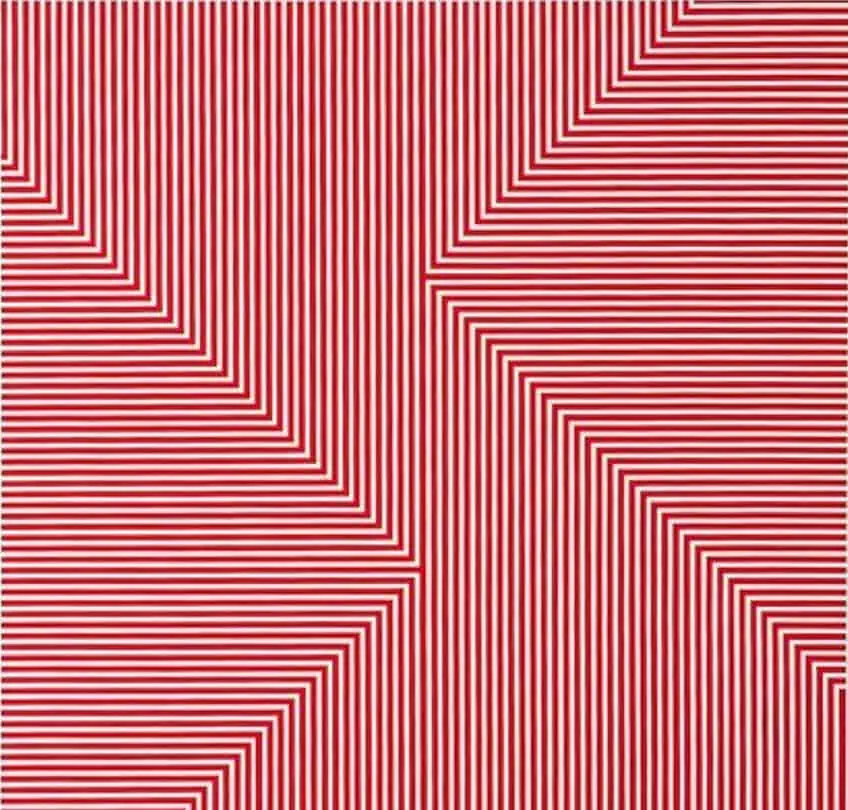
Omar Rayo (1928 – 2010)
| Name | Omar Rayo Reyes |
| Date of Birth | 20 January 1928 |
| Date of Death | 7 June 2010 |
| Nationality | Colombian
|
| Associated Movements, Themes, and Styles | Op art, Modern art, and Plastic art |
| Mediums | Painting, sculpture, caricature, and ceramics |
| Famous Artworks | ● OVNI (1967) ● 9-Soles (1967) ● Kumo XV (1973) ● Saratoy III (1980) ● Omelemo II (1981) |
Omar Rayo was a Colombian master of Op art who left a profound impact on the art world through his exceptional visual language in optical illusion and design. Rayo was born in 1928 and spent several decades honing his talents and eventually creating some of the most exquisite works one could find from the Op art scene.
Rayon’s approach and style were shaped by a fusion of geometric abstraction and optical illusion techniques, which created strong compositions defined by precise lines and meticulous arrangements.
His work almost seems to pulsate off the canvas and elevated the Op art scene by presenting works that demonstrated the intricate folds and knots of life. Throughout his career, Rayo won many awards, including the Santiago Martinez Delgado National Award for engraving in 1968.

Yaacov Agam (1928 – Present)
| Name | Yaacov Agam |
| Date of Birth | 11 May 1928 |
| Date of Death | Present |
| Nationality | Israeli
|
| Associated Movements, Themes, and Styles | Op art, Modern art, Kinetic art, and Abstract art |
| Mediums | Sculpture and painting |
| Famous Artworks | ● Double Metamorphosis II (1964) ● Star of David (1983) ● Infinite Reach (1985) ● Hidden Rainbow x9 (2002) |
Yaacov Agam is an internationally acclaimed Op artist who is recognized as a trailblazer in the field of Op and kinetic art. Through themes such as space, time, progress, and the role of the observer, Agam pioneers innovative creations that incorporate materials such as metal, light, and paint to craft stunning optical illusions.
Sham’s style is characterized by his ability to produce mesmerizing and meaningful visual effects defined by bold colors and geometric patterns.
Born in 1928, Agam’s practice is also shaped by his experimentation with “Agamographs”, which describe his unique style and a form of lenticular printing that enables different scenes to emerge and is based on the viewer’s perspective. Agam’s technique involves a playful element of surprise that also engages the viewer in a captivating dance of perception. Must-see works by Yaacov Agam include Double Metamorphosis II (1964) and Infinite Reach (1985).
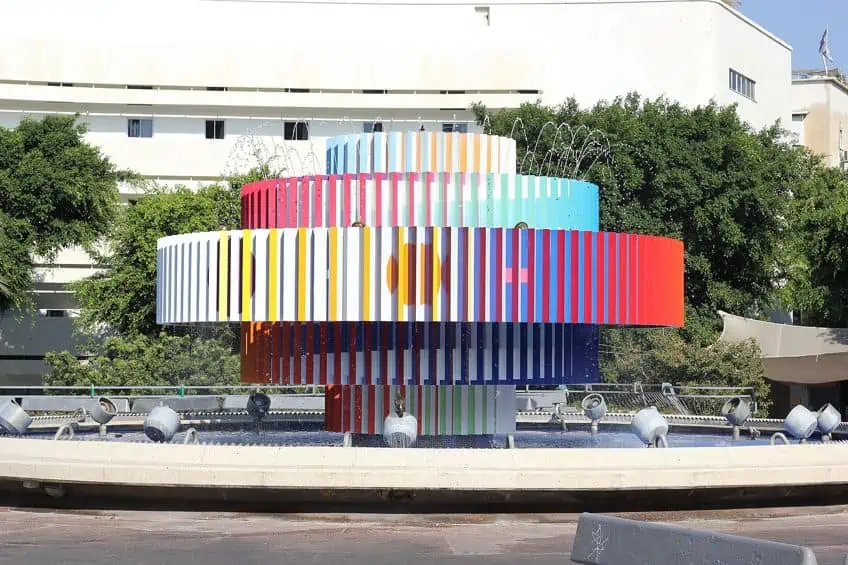
Julio Le Parc (1928 – Present)
| Name | Julio Le Parc |
| Date of Birth | 23 September 1928 |
| Date of Death | Present |
| Nationality | Argentine
|
| Associated Movements, Themes, and Styles | Op art, Modern art, Abstract art, Contemporary art, and Kinetic art |
| Mediums | Painting, installation, and sculpture |
| Famous Artworks | ● Formes Virtuelles Par Déplacement du Spectateur (1969) ● Composition Cinétique (1970) ● Ondes 134, Serie 3 (1973) ● Alchimie #207 (1992) |
Julio le Parc is one of the most iconic Op artists of the 21st century whose detailed Op art paintings are considered masterpieces of the movement. The Argentine artist is also a leader in abstraction and kinetic art who has won many prolific awards during his lifetime.
From an early age, Parc took an interest in all things Avant-Garde, and as such, he went on to become one of the major artists of Modern art.
Parc’s first major work in 1968 titled Lumiére en Vibration showcased a controlled display of light that shone through sheets of plexiglass at regular intervals, which created a prism of light that pulsed like a heartbeat. Parc’s intervention with light and space was a direct criticism of the static nature of art and the notion of an extraordinary artist. Today, Parc’s works are housed in many prestigious museums and collections, including The Museum of Modern Art and the Tate Gallery.
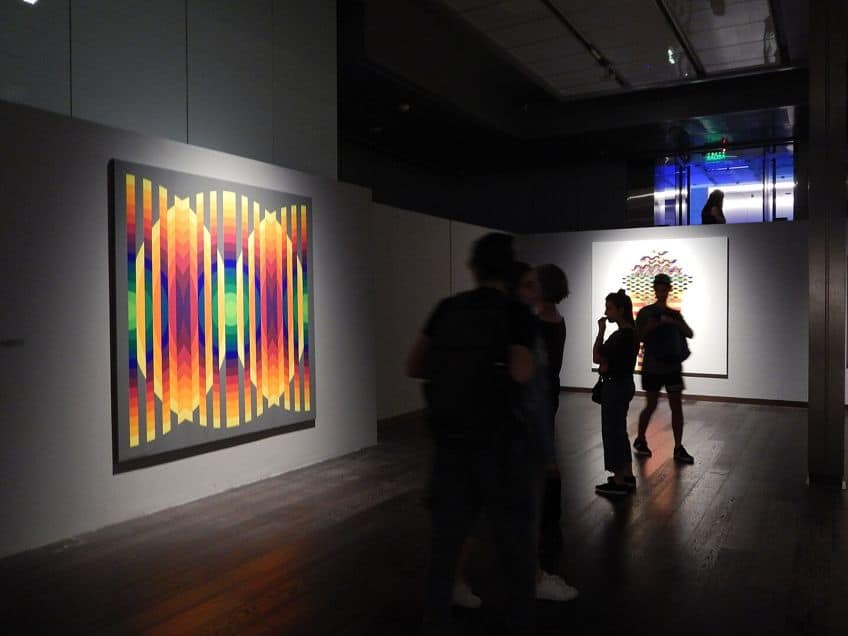
Richard Anuszkiewicz (1930 – 2020)
| Name | Richard Anuszkiewic |
| Date of Birth | 23 May 1930 |
| Date of Death | 19 May 2020 |
| Nationality | American
|
| Associated Movements, Themes, and Styles | Op art, Contemporary art, Modern art, and hard-edge painting |
| Mediums | Painting, sculpture, and printmaking |
| Famous Artworks | ● Fluorescent Complement (1960) ● Knowledge and Disappearance (1961) ● Spectral Nine (1969) ● Temple of Dee Crimson (1985) |
Richard Anuszkiewicz was a leading figure of the Op art movement who leveraged geometric compositions to captivate his viewers and create visually disorienting art. Anuszkiewicz was born in 1930 and experimented with different approaches to color throughout the 20th century.
With a preference for vibrancy and disorientation, Anuszkiewicz’s style was shaped by his precision in carefully calibrating his use of color to create intense visual effects that appear as though the shapes are vibrating.
His works appear to also transform and shift with color such that the work engulfs the spectator. Among his most notable contributions to Op art was his application of color theory and exploration of perceptual phenomena, which expanded the boundaries between art and illusion.
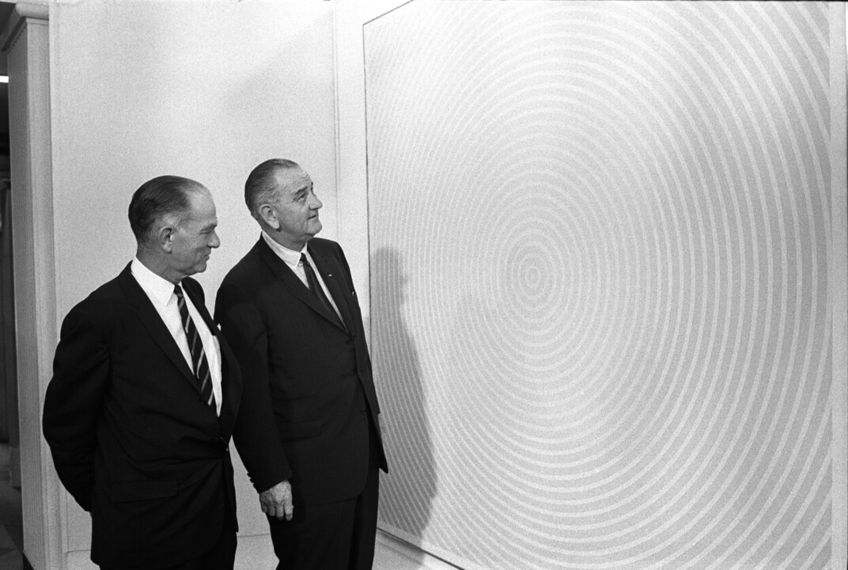
Bridget Riley (1931 – Present)
| Name | Bridget Louise Riley |
| Date of Birth | 24 April 1931 |
| Date of Death | Present |
| Nationality | English |
| Associated Movements, Themes, and Styles | Op art, Modern art, and hard-edge painting |
| Medium | Painting |
| Famous Artworks | ● Pink Landscape (1960) ● Movement in Squares (1961) ● Blaze Study (1962) ● Cataract 3 (1967) |
Bridget Riley is among the most renowned Op artists of the 21st century and is best known for the use of hard-edge painting in Op art. Riley’s optical illusions feature trippy and surreal geometric patterns that distort the representation of two-dimensional space and make her works appear to possess an almost three-dimensional quality. Hard-edge painting was a technique that emerged as part of Abstract art and involves the application of paint, such that there are abrupt transitions between colors. This technique is closely related to styles of paintings found in geometric abstraction, color field painting, and post-painterly abstraction.
Riley’s use of color examines the ways that a select group of colors fuse and interact with one another.
Riley’s approach to Op art painting relies on repetition, juxtaposition, and the dynamism of color, such that her works mimic the works of Neo-Impressionists like Georges Seurat. Seurat’s Pointillism technique inspired Riley to pursue abstract painting, which developed around the 1960s. Riley’s process begins with small color studies executed in gouache, which progresses to large-scale canvas works in acrylic and then oil. Today, Bridget Riley is considered to be among the top 10 most expensive British artists of Op art on the art market for her long standing reputation as the “it-girl” of Op art. In addition to her success in the Contemporary era, Bridget Riley was also the first woman to receive the prestigious Dutch award, the Sikkens Prize, which saw critics describe her work as pure, precise, and subtle. A few Op art examples from Riley’s best works include Movement in Squares (1961), Cataract 3 (1967), and Intervals 1 & 2 (2019).
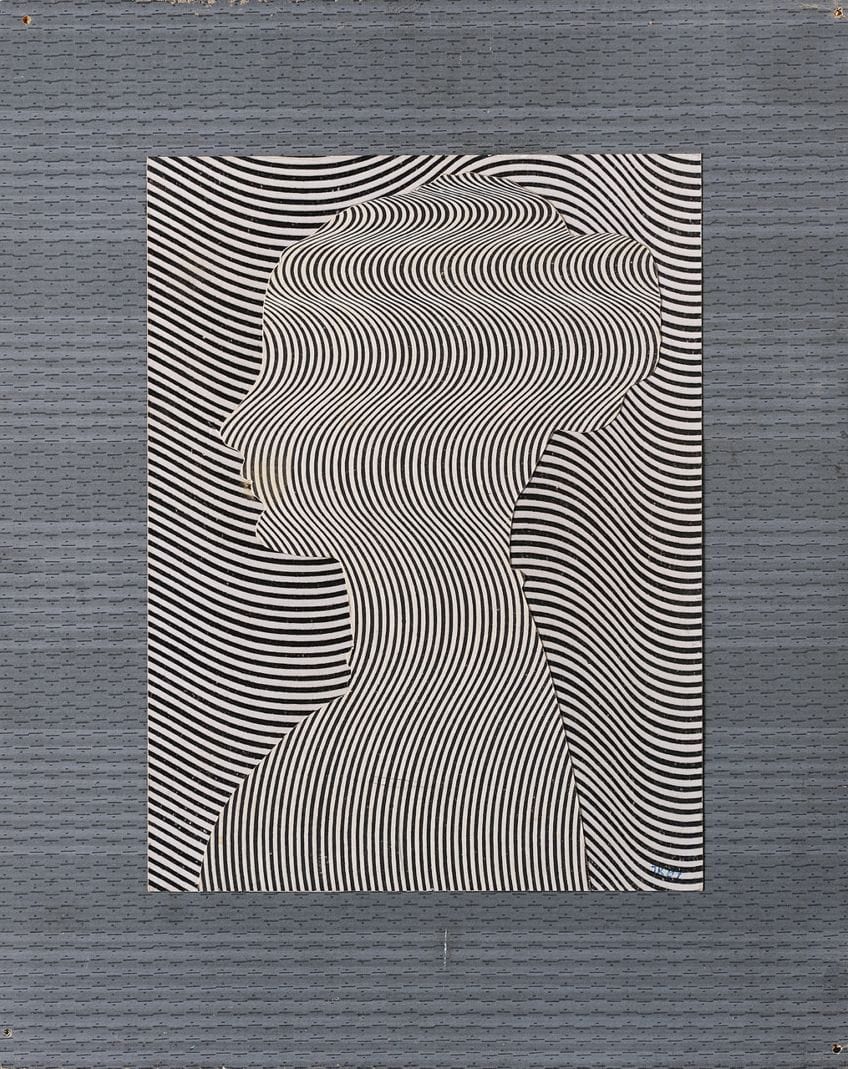
Jean-Pierre Vasarely (1934 – 2002)
| Name | Jean-Pierre Vasarely (also known as Jean-Pierre Yvaral) |
| Date of Birth | 25 January 1934 |
| Date of Death | 2 August 2002 |
| Nationality | French |
| Associated Movements, Themes, and Styles | Op art, Kinetic art, and Modern art |
| Mediums | Painting and printmaking |
| Famous Artworks | ● Progression Polychrome (1970) ● Cristallisation Bleue (1972) ● Étoile (1975) ● 50 Shades of Blue (1976) ● COMPOSITION (c. 1970 – 1980) |
Jean-Pierre Vasarely, who was also recognized professionally as Jean-Pierre Yvaral, was the son of Op art legend Victor Vasarely, who specialized in the field of Op art during the 1950s. Yvaral’s introduction to Op art was almost seamless and he fully embraced the idea of incorporating geometry in art and its power to the development of Modern art.
Yvaral was the first artist to describe art created in an algorithmic nature as “numerical art” and included digital manipulation in his production process.
Yvaral edited and distorted his source images, which were then used to create his enigmatic and multi-dimensional paintings. Yvaral’s vibrant geometric abstractions showcased his interest in monochrome abstraction and by 1960, Yvaral established the Le Group de Recherche d’Art Visuel alongside other artists such as Julio le Parc and François Morellet. A selection of Yvaral’s Op art examples include works such as Étoile (1975) and 50 Shades of Blue (1976).
Frank Stella (1936 – Present)
| Name | Frank Philip Stella |
| Date of Birth | 12 May 1936 |
| Date of Death | Present |
| Nationality | American |
| Associated Movements, Themes, and Styles | Op art, Modern art, Minimalism, Contemporary art, and post-painterly abstraction |
| Mediums | Painting, sculpture, and printmaking |
| Famous Artworks | ● The Marriage of Reason and Squalor (1959) ● Six Mile Bottom (1960) ● Hyena Stomp (1962) ● Harran II (1967) |
This iconic New York-based artist is one of the best Op artists of all time. Inspired by music, metaphysics, psychology, and Abstract Expressionism, Frank Stella’s Op artworks are among the most famous pieces of Op art from the 20th century. Stella was also commissioned to create the new logo for the Metropolitan Museum of Art’s Centennial celebration in 1969. Stella’s contributions also include the introduction of Maximalist paintings, which prioritized the sculptural qualities of paintings. A decade ago, Stella also began producing star-shaped monochrome sculptures using computers for painting additions. Stella’s paintings from the 20th century can be defined by their use of arcs and squares, which produced elaborate designs and sculptures. Today, Frank Stella is recognized as an icon in the art world and the New York art scene as a master of Modern art.

These famous Op artists have created some of the most elaborate and mind-boggling Op artworks in art history that continue to inspire those interested in color theory, optical illusions, and geometric abstraction. By studying and analyzing the various Op art examples and artists who shaped the foundations of Modern art, one can be sure to find many gold nuggets of tips and techniques that can enhance one’s exploration of visual perception.
Frequently Asked Questions
Who Are the Three Most Famous Op Artists?
Among the many iconic artists of the Op art movement were figures such as Victor Vasarely, Jesus Rafael Soto, and Bridget Riley, who are considered to be the most important and renowned Op artists.
Who Is the Most Expensive Op Artist on the Art Market?
According to a study of works sold on auction in 2012, the most expensive Op artist was found to be Carlos Cruz-Diez, whose 1965 painting, Physichromie 164, sold for $722,500 in 2012 at Christie’s in New York.
Which Three Artists Are Credited With Founding the Op Art Movement?
Before the 1960s list of famous Op artists, figures such as Maurits Cornelis Escher, Victor Vasarely, and Josef Albers have been credited with founding the Op art movement through their experiments with optical art.
Nicolene Burger, a South African multimedia artist and creative consultant, specializes in oil painting and performance art. She earned her BA in Visual Arts from Stellenbosch University in 2017. Nicolene’s artistic journey includes exhibitions in South Korea, participation in the 2019 ICA Live Art Workshop, and solo exhibitions. She is currently pursuing a practice-based master’s degree in theater and performance. Nicolene focuses on fostering sustainable creative practices and offers coaching sessions for fellow artists, emphasizing the profound communicative power of art for healing and connection. Nicolene writes blog posts on art history for artfilemagazine with a focus on famous artists and contemporary art.
Learn more about Nicolene Burger and about us.
Cite this Article
Nicolene, Burger, “Famous Op Art Artists – Explore Artists Who Trick the Eye.” artfilemagazine – Your Online Art Source. September 1, 2023. URL: https://artfilemagazine.com/famous-op-art-artists/
Burger, N. (2023, 1 September). Famous Op Art Artists – Explore Artists Who Trick the Eye. artfilemagazine – Your Online Art Source. https://artfilemagazine.com/famous-op-art-artists/
Burger, Nicolene. “Famous Op Art Artists – Explore Artists Who Trick the Eye.” artfilemagazine – Your Online Art Source, September 1, 2023. https://artfilemagazine.com/famous-op-art-artists/.


